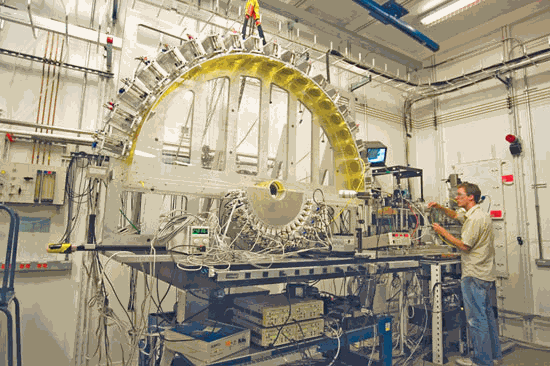Tim Fister, who is currently a postdoc in the Argonne Materials Science Division working with Paul Fuoss, has been awarded the Henderson Prize by the University of Washington (UW) Physics Department for the outstanding Ph.D. thesis from his graduating year. The title of his thesis was, “Momentum-dependent x-ray Raman scattering."
As part of his Ph.D. research, Fister designed, helped construct, and commissioned the lower-energy-resolution inelastic scattering (LERIX) spectrometer permanently installed at the XOR/PNC beamline 20 ID-B at the Advanced Photon Source (APS). The LERIX instrument is a large multielement spectrometer consisting of 19 analyzers arranged in a semicircle and mounted in an aluminum frame. The LERIX allows high-energy, nonresonant inelastic x-ray scattering experiments with a great deal of versatility and adaptability to the needs of individual users. (For more on LERIX, see “LERIX: Pinning Down the q in XRS,” APS Science 2006, ANL-06/23, pg. 134.
Tim Fister (University of Washington) at the LERIX detector installed on the XOR/PNC 20 I-D-B beamline.
Prof. Jerry Seidler of the University of Washington, Fister’s thesis advisor, said, "Tim's dissertation was outstanding in all regards: instrumentation, experimentation, data analysis, and theory. His work on instrumentation will likely have the longest lasting impact. LERIX is the first instrument optimized for rapid measurement of the momentum-transfer dependent component of nonresonant x-ray Raman scattering. In three years of regular operation, there are well over 20 LERIX-based manuscripts completed or in preparation with applications spanning battery technology, catalysis, hydrogen fuel storage, actinide chemistry, magnetism, correlated electron phenomenon, geophysics, and even gas-phase atmospheric science."
The Henderson Prize commemorates Professor Joseph Henderson and his wife. Prof. Henderson joined the faculty of the University of Washington in 1929. Mrs. Henderson was precluded from regular faculty appointment by the anti-nepotism rules in effect, although she taught occasional courses. The first Ph.D. awarded by the Department of Physics was earned by one of Professor Henderson's students in 1934, and in all 25 students received Ph.D.'s under Prof. Henderson's guidance. Research in nuclear physics at UW began when he and his students undertook to build a high-voltage x-ray source for the Swedish Hospital to use in cancer therapy. Prof. Henderson contributed substantially to the physics war effort in World War II and he established the UW Applied Physics Laboratory afterwards. He served as Director of the Laboratory until 1969. The Prize is financed by the Henderson Family Fund, established in 1983 by the gifts from Prof. and Mrs. Henderson, their family, friends, colleagues, and former students.

